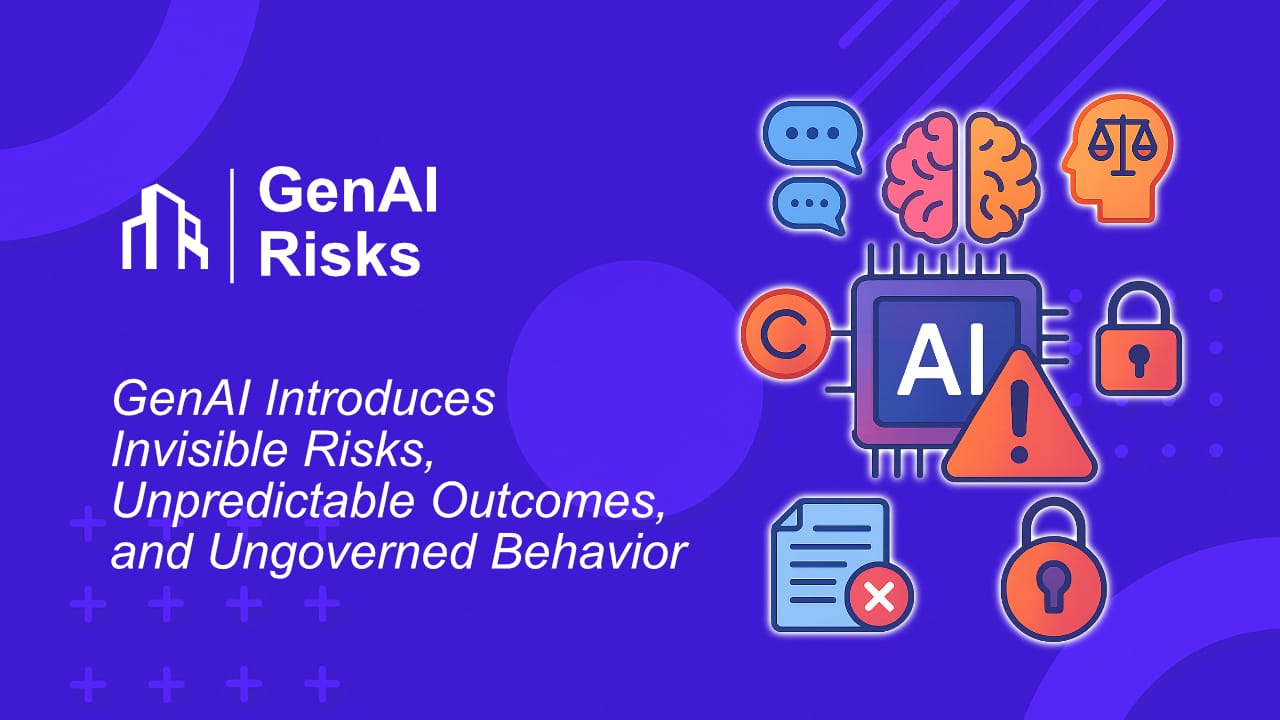GenAI Risks: From Emerging Threats to Governance Action
GenAI is reshaping how decisions are made, content is generated, and actions are taken, but it also introduces unpredictable risks. From prompt injection to agent autonomy, traditional governance no longer applies.

The rise of Generative AI (GenAI) marks a new chapter in the digital transformation of organizations. It is no longer just a tool for innovation, it is reshaping entire operating models, decision-making chains, and customer experiences. But with this power comes an urgent need to rethink risk.
Traditional governance frameworks are not designed for self-directed systems that learn, adapt, and act. GenAI introduces volatile, opaque, and fast-evolving threat surfaces. From data leaks to deepfakes, from agent drift to embedded bias GenAI doesn’t just create risk, it amplifies and hides it.
In this comprehensive overview, we outline the key GenAI risks, why current governance fails to contain them, and how to design a resilient and future-proof governance framework.
1. GenAI-Specific Threat Categories
1.1 Unintended Output and Hallucinations
Unlike deterministic software, GenAI tools may produce plausible yet incorrect, misleading, or entirely fabricated results often without obvious signals of failure. These “hallucinations” can corrupt data, mislead users, or be used maliciously without detection.
1.2 Data Leakage via Prompt Inputs
Prompts that include sensitive data (e.g., customer records, contracts) risk leakage through logging, model fine-tuning, or unexpected output regurgitation. The rise of prompt engineering has exposed this loophole as both a security and IP concern.
1.3 Prompt Injection and Malicious Instruction
Users or adversaries can craft inputs that hijack the model’s behavior a form of injection attack that bypasses guardrails or executes unauthorized tasks. This is especially dangerous in agents with action-taking capabilities.
1.4 Unauthorized Agent Autonomy
When agents initiate tasks across apps, APIs, or databases, small logic errors or misunderstood goals can lead to real-world impact including unauthorized purchases, misrouted data, or regulatory violations.
1.5 Deepfake Generation and Identity Spoofing
The ability to replicate voices, faces, signatures, or tone of writing at scale introduces legal, reputational, and safety risks. Organizations must consider not only producing such content but also defending against it.
1.6 Bias Amplification and Discrimination
Models trained on biased data risk amplifying social, legal, or commercial discrimination and doing so invisibly. Without clear oversight, this can erode trust, fuel lawsuits, and worsen inequalities.
1.7 Supply Chain and Vendor Model Risk
Many organizations use third-party GenAI APIs without full understanding of their models, training data, update cycles, or retention policies creating a shadow governance risk across supply chains.
2. Why Traditional AI Governance Fails
2.1 Static Checklists Can’t Manage Dynamic Systems
GenAI’s behavior is emergent, not rule-based. Traditional governance relies on static audits, predefined rules, and after-the-fact reviews none of which are sufficient for systems that evolve with every input.
2.2 Data Governance ≠ Model Governance
Many companies mistakenly apply data governance controls to GenAI systems, assuming model behavior is predictable. In reality, data is only one variable; model architecture, temperature, prompt history, and external tools all affect output.
2.3 Siloed Risk Ownership Fails
GenAI touches marketing, sales, legal, ops, HR, and IT but few organizations have centralized accountability. Without cross-functional alignment, oversight collapses.
2.4 Overreliance on Vendor Guardrails
Trusting model providers to “bake in safety” is risky. Vendor updates can shift model behavior overnight, and APIs often lack transparency into training data or failure modes.
3. Building GenAI-Aware Governance
3.1 Model Usage Inventory and Mapping
Start with a complete map of which departments use which GenAI tools including unofficial ones. Classify tools by purpose, risk exposure, and control level.
3.2 Tiered Risk Categorization
Assign risk levels (low/medium/high/critical) based on the system’s autonomy, decision-impact, data sensitivity, and end-user exposure. Tie this to policy, audit, and approval layers.
3.3 Human Oversight with Delegation Boundaries
Every autonomous agent must have an explicit override structure and accountability owner. No system should be “fire and forget.”
3.4 Prompt Monitoring and Retention Controls
Record and audit prompts and outputs where sensitive actions are involved. Set time-based deletion rules and restrict copy-paste of critical data into public models.
3.5 Red-Teaming and Stress Testing
Simulate adversarial input attacks, output corruption, and prompt injection. Develop structured response playbooks based on scenario outcomes.
3.6 Audit Trails and Explainability Logs
Capture input/output history, decision-path summaries, and fallback logic. This is critical not just for incident response, but for future-proof compliance.
3.7 Ethics Reviews and Inclusion Audits
Ensure outputs across HR, marketing, and external content generation meet fairness, accuracy, and accessibility standards.
4. Practical Governance Tactics
- Introduce GenAI security training for all staff
- Use enterprise-grade model access platforms with user-level controls
- Require pre-deployment model behavior testing
- Appoint a GenAI governance lead with cross-departmental authority
- Include GenAI criteria in vendor procurement reviews
- Limit autonomous agent capabilities by default
5. Moving Forward with Confidence
Ignoring GenAI risk is not an option. Whether you’re using internal LLMs, third-party APIs, or agent-based systems, governance must evolve not lag behind. The right approach isn’t more complexity. It’s clarity:
- Who’s using GenAI?
- What are the risks?
- How are we controlling them?
Those who answer these questions first will scale faster, avoid crises, and build trust as GenAI moves from test phase to infrastructure layer.
Want to align your AI use with modern governance standards?
Scalevise helps organizations implement practical, risk-aligned GenAI strategies that scale safely.
